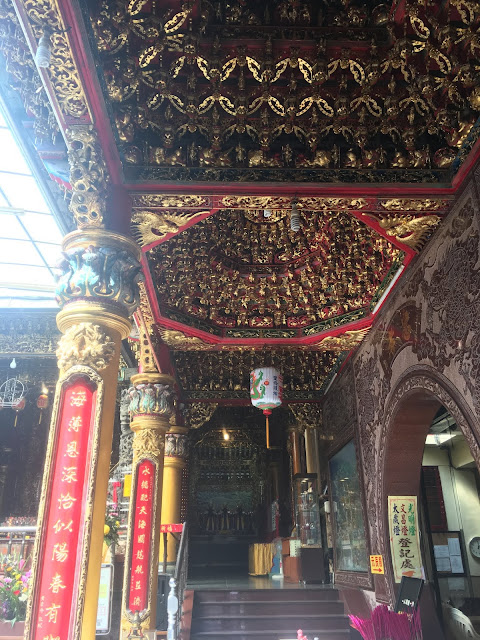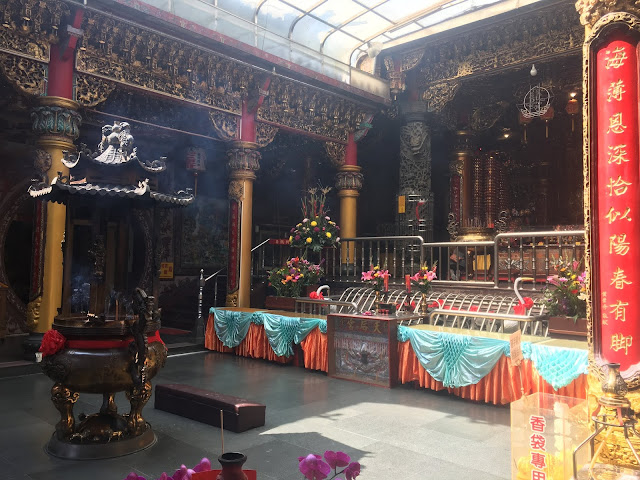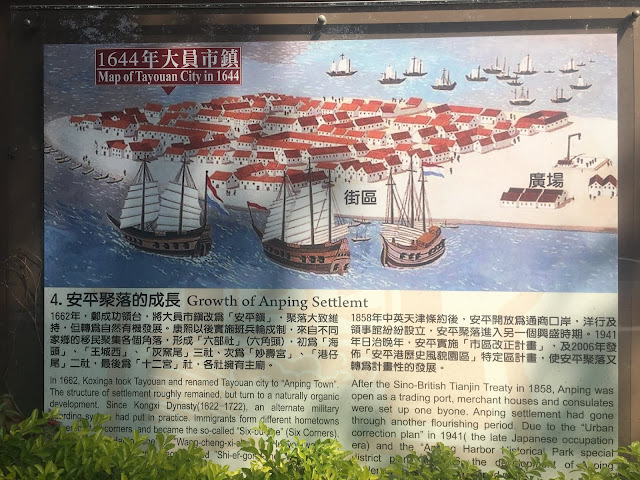It's our second time visiting Anping. Two years ago, we visited the five most popular places that can be visited with a single ticket. This time, I wanted to see some places we missed before. We visited Sio House (Salt Museum), Oyster Shell Kiln, Temple, Old Street, forts and castle and some smaller ancient buildings. Some places are free to visit, while others have an entrance fee of 50 NTD. Anping is one of my favorite places to visit, as it is full of history and street food can be found everywhere. In March 2012, Anping was named one of the Top 10 Small Tourist Towns by the Tourism Bureau of Taiwan. The older place name, Tayouan, comes from a nearby Taiwanese aboriginal tribe and was given by the Dutch and Portuguese. Han immigrants later renamed the area "Anping" after the Anping Bridge in Fujian. Soon after Qing rule was established in 1683, the name "Taiwan" (臺灣) was officially used to refer to the entire island with the establishment of Taiwan Prefecture.
Tainan Grand Mazu Temple (臺南祀典大天后 大媽祖廟)
Tainan Grand Mazu Temple (臺南祀典大天后 大媽祖廟) is one of the four largest temples in Anping. According to Qing dynasty records, the temple was originally called "Tianfei Palace" and was located at the ferry in Anping Town (now Shimen Elementary School). During the Japanese rule, it was demolished and sold for some time. The temple was rebuilt in 1962 on the site of the Shui Shimen Gate in the Qing Dynasty. The original Tianfei Palace site monument is located outside the fence on the north side of Shimen Elementary School.
The exact founding date of the Tianhou Palace in Anping is not mentioned in the Chronicles of the Qing Dynasty, but the earliest record of its opening is found in the "Fujian Tongzhi" from 1686. It was explicitly stated as being built in 1668 in 1933. Scholars have debated whether Ming Zheng had a popular belief in Mazu, with some supporting the construction during the Ming Zheng period and others questioning it.
In the early days of the Qing Dynasty, Anping was prosperous as an important port, and the Tianhou Palace also enjoyed a flourishing incense. However, with the development of ports in other regions and the gradual decline of Anping Port, the prosperity of the Tianhou Palace was also affected.
According to records from Anping literati Lin Yong's interview with Lao Lao, when the Japanese entered Anping in 1895, there were still Qing soldiers in the Tianhou Palace. However, the palace was later besieged by the Japanese, and only one soldier managed to escape. The Japanese army then dug a pit behind the temple and buried the 56 soldiers who were killed. Subsequently, there were reports of frequent occurrences of injustice near the Tianhou Palace, which led to the gradual abandonment of the temple.
During the early days of Japanese rule, the Anping Tianhou Palace served as an official residence. It was managed by the Japanese Army Operations Department and used by the military police. When the military police withdrew, the Anping Post and Telecommunications Sub-branch was established in 1896. In 1900, the Tianhou Palace served as the classroom of Anping Public School (the predecessor of Shimen Elementary School). The temple was demolished in 1918.
After the Second World War, the local people expressed their desire to rebuild the Tianhou Palace, and it was reconstructed in 1962 with permission granted by the Tainan Municipal Government on the former site of the Shimen Yamen of Anping Castle. The temple continued to expand and was completed around 1975. However, a fire broke out in 1990, although the three statues of Mazu survived.
The main building of the temple is a reinforced concrete and soil structure constructed in 1962, with its main entrance facing northwest. The Sanchuan Hall has a double-eaved roof covered with green glazed tiles, and a pair of stone lions are placed in front of the temple and at the entrance. The Tianhou Palace worships the Heavenly Mother along with the gods of Yanping County, the King of the Five Narcissus, the King of the Four Sea Dragons, Dou Yuanjun, Taisui Xingjun, Wenchang Emperor, and General Shi. The main hall enshrines three soft-body statues of Mazu, each about four feet high, with their hair styled in the Meizhou tradition and holding three-inch golden lotuses. They have a peaceful appearance, and their forefoot follows the style of the Song Dynasty, making them quite precious.
See also: Luerhmen Mazu Temple
See also: Sio House Salt Museum

Anping Old Settlement Historical Park (安平舊聚落歷史公園)
Anping Old Settlement Historical Park (安平舊聚落歷史公園) has become an important symbol representing Anping. To further preserve and promote the settlement culture, a sculpture called "Master (dressing)" by master sculptor Chen Zhengxiong is installed in the park. The sculpture is inspired by the artist's nostalgia for his parents and aims to convey the peace and warmth of parental love to others. The Anping Old Settlement Historical Park integrates local culture, environment, art, and an interesting garden setting.


























0 komentarze:
Post a Comment